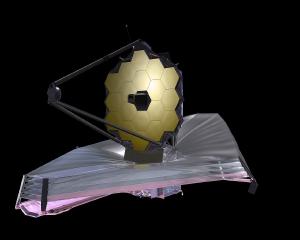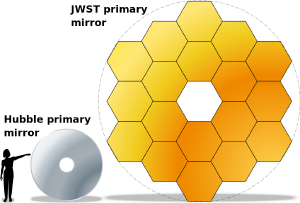Blog
A Deeper Sky
13 May 2015
 NASA
NASAThe James Webb space telescope is scheduled to launch in 2018. It’s often dubbed as the replacement for the Hubble space telescope since, like Hubble, it will be able to see distant objects with great detail. But the Webb has some significant differences because of its primary goal, which is to see deeper into the sky than ever before.
While you might think that seeing farther is simply a matter of better resolution, that isn’t quite the case. Why, for example, can the Hubble observe distant galaxies in detail, but can’t clearly resolve the surface of Pluto? It all has to do with the apparent size of Pluto vs a distant galaxy. A galaxy can be billions of times more distant than Pluto, but it’s also much larger, so the apparent size of even the most distant galaxies is larger than that of Pluto. Hubble can see the Andromeda galaxy in awesome detail because it’s apparent size is about 6 times larger than the Moon. It is true that more distant objects tend to have a smaller apparent size than closer ones, but it’s not just resolution that limits depth of view.
 Wikipedia user Bobarino
Wikipedia user BobarinoTo outperform Hubble, the Webb not only has to be larger, it also needs to be more sensitive at infrared wavelengths. That’s because the more distant the galaxy the greater its redshift. For the most distant galaxies, much of their light is redshifted well into the infrared. Since the Hubble telescope focused on visible and near infrared wavelengths, the most distant galaxies it can observe have a redshift of about z = 12. Beyond that and a galaxy’s light is too redshifted for Hubble to observe. We think the very first galaxies formed at a redshift of about z = 15, so the Hubble can’t see them at all.
As a result, the Webb will focus primarily on infrared wavelengths, and it will do so at the cost of seeing less of the visible spectrum. For example, its mirrors are made with a layer of gold, which is very effective at infrared wavelengths but actually absorbs blue wavelengths. So the Webb won’t be able to observe things at the blue end of the visible spectrum. It will, however, be able to see objects at redshifts of nearly z = 20, which is so redshifted that ultraviolet light is seen as infrared. The Webb will also be able to observe objects 100 times more faint than the Hubble, which is important since deeply redshifted objects are also much more dim.
In addition to observing the rise of the earliest galaxies, it will also be able to study dark matter and dark energy. Over its lifetime, Webb is expected to observe millions of galaxies and hundreds of thousands of distant supernovae. From this we’ll be able to get a better measure of these phenomena. We should be able determine if the universe is truly flat, and the role dark matter plays in the formation of galaxies.